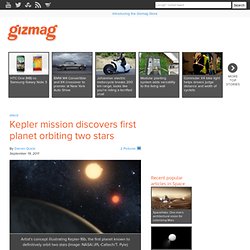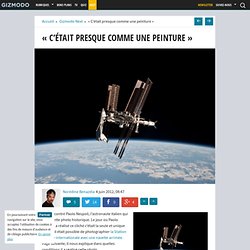

Fermi telescope detects signal that could be annihilating dark matter. Researchers using data obtained by the orbiting Fermi Telescope may have found the first clear, direct evidence of dark matter in our own galaxy.

The signal comes in the form of an excess of gamma rays coming from an area surrounding the galactic core, and it appears to be exactly what we'd expect from a weakly interacting massive particle, or WIMP. Perhaps as significantly, however, there are no known astronomical features that can produce a signal like this. The Universe provides plenty of evidence that dark matter exists. Everything from the behavior of galaxies to the structure of galaxy clusters indicates that there's more matter present than we can detect. We have spotted instances of gravitational lensing by matter in what appears to be largely empty space. But when it comes to identifying the particles that actually comprise dark matter, we've tended to look closer to home.
But another category of experiments has looked where the evidence already exists: in the skies. Kepler mission discovers first planet orbiting two stars. Artist's concept illustrating Kepler-16b, the first planet known to definitively orbit two stars (Image: NASA/JPL-Caltech/T.

Pyle) Image Gallery (2 images) Hubble's Most Mind Expanding Photos of the Universe. The just-turned-21 Hubble Space Telescope has spent its entire life taking photographs of such enormous, otherworldly things that words stop working.

And the events in its photographs happened so long ago, notions of time stop working too. But don’t speak, and forget about the time. Distances from the Sun. Lexique d'astronomie. Explore the planet Mars with realistic Mars habitats, rockets, ground cars and robots. 15 Mind-Blowing Featured Images by NASA. The NASA Goddard Space Flight Center is home to the United States’ largest organization of combined scientists, engineers and technologists that build spacecraft, instruments and new technology to study the Earth, the sun, our solar system, and the universe.

They are also home to some of the most amazing images, visualizations and videos NASA has to offer! Please do yourself a favour and check out their incredible Flickr page which has thousands of images with wonderfully detailed descriptions. Below is a collection of 15 mind-blowing featured images from NASA. Enjoy! 1. The STEREO (Ahead) spacecraft caught this spectacular eruptive prominence in extreme UV light as it blasted away from the Sun (Apr. 12-13, 2010). Le moteur 3D de vos rêves. SDO_Earth_scale-EDIT2.jpg (Image JPEG, 975x1000 pixels) - Redimensionnée (62%) Solar Nirvana / 6 November 2011. Mysterious Object Floating Past Mercury? - Space News. December 9, 2011 A NASA telescope has revealed a gigantic object the size of a planet floating around Mercury, leading some to believe it could be a UFO.

The object appears in a video sequence of images of a coronal ejection from the Sun. « C’était presque comme une peinture » J’ai rencontré Paolo Nespoli, l’astronaute italien qui a pris cette photo historique.

06/06 > BE Allemagne 574 > La présence de méthane sur Mars ne signifie pas nécessairement la vie. Recherche spatialeLa présence de méthane sur Mars ne signifie pas nécessairement la vie.

05/31 > BE France 270 > Exploration de l'Univers : MIRI passe avec succès les tests pour son intégration au James Webb Space Telescope (JWST) Actualité InnovationExploration de l'Univers : MIRI passe avec succès les tests pour son intégration au James Webb Space Telescope (JWST) Projet commun aux agences spatiales américaine (NASA), canadienne (CSA) et européenne (ESA), le James Webb Space Telescope (JWST) est un satellite de plus de six tonnes équipé du plus grand télescope spatial jamais construit, son diamètre étant de 6,5 mètres.

Transiting from Air to Space. The first call for an X-15-class research vehicle came from Robert J.

Woods, a colleague of Walter Dornberger at Bell, during a meeting of the prestigious NACA Committee on Aerodynamics on October 4, 1951. He reiterated his support for such a vehicle during subsequent meetings and, as a result, the NACA committee passed a motion on June 24, 1952 that charged the agency to expand its research aircraft program to include studying the problems of manned and unmanned flight at altitudes between 12 and 50 miles, and velocities of Mach 4 to Mach 10, as well as devoting "a modest effort" to study exoatmospheric flight from Mach 10 to escape velocity. The major NACA field centers exchanged various paper plane proposals. NACA engineers L. 04/30 > BE Canada 403 > Vent solaire, poussière de Lune, et lumières Martiennes.
Top Story - CHANGES IN THE EARTH'S ROTATION ARE IN THE WIND - March 4, 2003. Because of Earth’s dynamic climate, winds and atmospheric pressure systems experience constant change.

These fluctuations may affect how our planet rotates on its axis, according to NASA-funded research that used wind and satellite data. NASA’s Earth Science Enterprise (ESE) mission is to understand the Earth system and its response to natural and human-induced changes for better prediction of climate, weather and natural hazards, such as atmospheric changes or El Niño events that may have contributed to the affect on Earth’s rotation. “Changes in the atmosphere, specifically atmospheric pressure around the world, and the motions of the winds that may be related to such climate signals as El Niño are strong enough that their effect is observed in the Earth’s rotation signal,” said David A. Salstein, an atmospheric scientist from Atmospheric and Environmental Research, Inc., of Lexington, Mass., who led a recent study. Top 10 Most Important Discoveries in Astronomy. Astronomy is the cool, sexy field of the scientific world. Sure, biologists and chemists are out there curing diseases or whatever, but they’re just so boring.
Meanwhile, astronomers are busy showing us sweet pictures of distant planets and playing around with telescopes the size of buildings. How can you compete with that? You can’t, so here are the ten most important things astronomers throughout the ages have discovered: La Lune perturbe même les accélérateurs de particules. Un télescope à rayons X pour étudier les trous noirs. Projet Mars One : l'Homme posera le pied sur Mars en 2023. Deux planètes effroyablement proches. Kepler-36b est une exoplanète qui a tout récemment été découverte. Kepler-36c joue dans la même constellation, à tel point que les deux planètes pourraient presque se percuter !
Kepler-36b est dotée d’une composition rocheuse et est sensiblement de la même taille que notre planète, elle mesure 1,4 fois la taille de la Terre. L’autre protagoniste Kepler-36c, est une géante gazeuse chaude du type Neptune qui évolue également dans la constellation du Cygne. Et il s’en passe de belles à 1.200 années-lumière de la Terre. En effet, tous les 97 jours les orbites des planètes se croisent à une proximité affolante.
Le spectacle doit être hallucinant à voir. Le paradoxe ne s’arrête pas là. Or, Kepler-36b et Kepler-36c n’ont ni la même taille, ni la même composition et pourtant elles sont 30 fois plus proches que ce que l’on observe dans notre système solaire. 12 Pictures of Space You Won't Believe Aren't Photoshopped. Look, we all know that space is the final frontier, that space is cold and unforgiving and that in it, nobody can hear you scream. But what you might not know is that, when it thinks nobody is looking, space puts on a frilly dress, covers its forearms in honey and spins around until it falls over ... because space is just flat-out crazy as hell.
Oh, don't take our word for it or anything; we have photographic evidence. #12. Jupiter in Motion. Les premières images et surtout en couleur ! Amis exilés ou en retraite dans une montagne perdue, sachez que Curiosity, un énorme rover, a posé sa roue sur la planète rouge. Apparition et disparition d'une forme étrange sur Mars. Mais ... Infographic: Every Trip To The Moon, Ever. Once the U.S. planted a flag on the moon, it was easy to forget the trials and tribulations of the space race.
Future - Science & Environment - Drake equation: How many alien civilizations exist? Are we alone? It is a question that has occupied mankind for centuries. Today, we live in an age of exploration, where robots on Mars and planet-hunting telescopes are beginning to allow us to edge closer to an answer. Simuler l'univers grâce à un ordinateur portable ! File:Earth & Mir (STS-71).jpg. The Scale of the Universe 2 — Other Languages. Updated Theory: A Huge Chunk Of Earth, Blasted Away In A Collision, Is Now The Moon.
New simulations of a crash between Earth and a protoplanetary sister long ago could have produced a moon that's chemically similar to our planet, according to a new analysis. It bolsters a theory that the moon is part of Earth, and it helps settle a question about how this could be physically possible. Since around the time of the Apollo missions, lunar scientists have theorized that our moon formed after a horrendous collision between Earth and another world, which sheared off part of this planet.
But all the while, there's been a major disconnect with reality and the satisfying theoretical explanation of this concept. 5 New Space Projects Even More Awesome Than the Mars Rover. Don't get us wrong -- the landing of the Mars rover was a magnificent scientific achievement and a solemn testament to our species' ability to not completely screw things up every now and again. Unfortunately, rovers are not the stuff of laughably overwrought Aerosmith songs that you hear at junior proms. But what about these future missions? Et la galaxie la plus lointaine de notre Univers serait... La NASA minimise déjà sa découverte !
Découverte d'une planète solitaire. SpaceView, le programme pour traquer les débris spatiaux. Saturne, dans l'oeil du cyclone ! Forget Mars, NASA Probe Finds Ice and Organics on Mercury! Water ice and organics at Mercury's poles. The Oldest, Most Distant Object in the Universe Discovered. INFOGRAPHIC: Why asteroid mining is necessary. Vast Alien River System Spotted on Saturn's Moon Titan. Best Images and Videos From 3-Mile-Wide Asteroid Toutatis' Flyby. Black Marble : la Terre vue de nuit.
Neutron stars and black holes illuminate dark matter. Stagnation Temperature - Real Gas Effects. Lagrangian point.